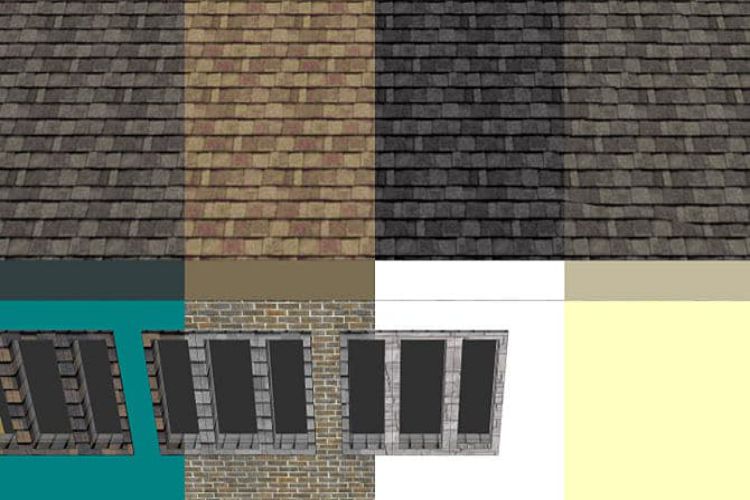Choosing the color of your roof shingles is an important decision that impacts the look and feel of your home. The right shingle color can enhance curb appeal, complement your home’s architectural style, and influence energy efficiency. While the selection might seem straightforward, it involves several considerations beyond simply picking a favorite color. Factors such as climate, neighborhood aesthetics, and personal taste play a role. We will explore how to thoughtfully navigate these choices to select a shingle color that suits your home’s character and lifestyle. We aim to help homeowners make an informed choice by highlighting key elements that should influence the selection process, resulting in a harmonious and lasting roof design.
Key Considerations When Selecting Shingle Color
1. Assess Your Home’s Exterior and Architectural Style
The first step in choosing a shingle color is to consider your home’s existing colors and architectural style. Consulting a roofing contractor in Pelham can provide valuable guidance to ensure the roof works harmoniously with the siding, trim, windows, and doors rather than clashing or standing out awkwardly. For example, traditional homes with brick or stone exteriors often pair well with neutral or earth-toned shingles like brown, gray, or muted reds. On the other hand, homes with painted siding in vibrant or pastel shades might benefit from shingles in softer or contrasting tones to balance the overall look.
Pay attention to the style of your home as well—modern designs might lean toward sleek, monochromatic shingles. In contrast, craftsman or cottage styles often feature textured, variegated shingles to add depth. Taking photographs of your home from multiple angles and reviewing the colors can help visualize how different shingle shades will integrate with the existing palette.
2. Consider the Climate and Energy Impact
Shingle color can influence your home’s energy efficiency, particularly in regions with extreme temperatures. Dark-colored shingles absorb more heat, which can increase cooling costs in warmer climates but help retain warmth in colder areas. Conversely, light-colored shingles reflect sunlight and keep the roof cooler, which may be beneficial in hot climates. Lighter shades like tan, light gray, or soft greens can help moderate indoor temperatures and reduce energy use if you live in an area with intense sun and heat.
Deeper colors like dark brown or charcoal might provide a slight insulation advantage for cooler regions. Beyond energy, consider the durability of the shingles in your climate—some colors may fade faster under strong sunlight or harsh weather, so checking the warranty and fade resistance for the color options can guide you toward a choice that lasts visually and structurally.
3. Examine Neighborhood and Community Standards
Your roof color doesn’t exist in isolation; it contributes to the broader streetscape and neighborhood aesthetic. Many homeowners associations and communities have guidelines or restrictions regarding roofing materials and colors to maintain a cohesive appearance. Even if no formal rules exist, observing the common shingle colors in your area can provide valuable insight into what works visually and might appear out of place. Selecting a color that complements neighboring homes helps preserve property values and creates a pleasant, unified community look.
If your neighborhood features neutral or natural tones, choosing a bold or unconventional color makes your home stand out, but not always in a good way. On the other hand, if you prefer your home to have a distinctive character, balancing uniqueness with neighborhood harmony is key. Talking to neighbors or local roofing contractors about common trends can be helpful before finalizing your decision.
4. Factor in the Roof’s Size and Pitch
The dimensions and slope of your roof affect how the shingle color appears from the ground and influence the overall impression. On large roofs, darker colors can create a dramatic, imposing look, while lighter shades can make the home feel more airy and open. The color choice for homes with steeply pitched roofs can emphasize height or create visual interest by contrasting with other exterior features. Low-slope roofs might call for colors that blend smoothly with the landscape, especially in rural or suburban settings.
If your roof has multiple sections or complex shapes, selecting a color that works well under varying light conditions is important. Testing color samples in natural daylight at different times can help you understand how shadows and sunlight interact with the shingles, preventing surprises after installation. Combining complementary shades in variegated shingles can add dimension and soften the visual impact on large or complicated roof structures.
Selecting the right shingle color for your home is a decision that blends aesthetic appeal with practical considerations. A well-chosen roof color complements your home’s design, suits the climate, and fits within the neighborhood context while accommodating your personal style and maintenance preferences. We have explored the main factors to consider—from matching architectural styles and evaluating energy efficiency to understanding community standards and roof characteristics.
Thoughtful consideration of these elements helps ensure your roof looks attractive and performs well over time. Your roof is a prominent feature that significantly influences your home’s curb appeal and value. Choosing a color that balances beauty, functionality, and longevity creates a welcoming, harmonious exterior that you can appreciate every day.

